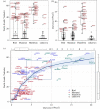The African mosquito-borne diseasosome: geographical patterns, range expansion and future disease emergence
- PMID: 38018102
- PMCID: PMC10685135
- DOI: 10.1098/rspb.2023.1581
The African mosquito-borne diseasosome: geographical patterns, range expansion and future disease emergence
Abstract
Mosquito-borne diseases (MBDs) threaten public health and food security globally. We provide the first biogeographic description of the African mosquito fauna (677 species) and the 151 mosquito-borne pathogens (MBPs) they transmit. While mosquito species richness agrees with expectations based on Africa's land surface, African arboviruses and mammalian plasmodia are more speciose than expected. Species assemblages of mosquitoes and MBPs similarly separate sub-Saharan Africa from North Africa, and those in West and Central Africa from eastern and southern Africa. Similarities between mosquitoes and MBPs in diversity and range size suggest that mosquitoes are key in delimiting the range of MBPs. With approximately 25% endemicity, approximately 50% occupying one to three countries and less than 5% occupying greater than 25 countries, the ranges of mosquitoes and MBPs are surprisingly small, suggesting that most MBPs are transmitted by a single mosquito species. Exceptionally widespread mosquito species feed on people and livestock, and most are high-altitude-windborne migrants. Likewise, widespread MBPs are transmitted among people or livestock by widespread mosquitoes, suggesting that adapting to people or livestock and to widespread mosquito species promote range expansion in MBPs. Range size may predict range expansion and emergence risk. We highlight key knowledge gaps that impede prediction and mitigation of future emergence of local and global MBDs.
Keywords: arbovirus; biodiversity; disease ecology; global health; one health; vector-borne diseases.
Conflict of interest statement
We declare we have no competing interests.
Figures







Similar articles
-
Diversity, composition, altitude, and seasonality of high-altitude windborne migrating mosquitoes in the Sahel: Implications for disease transmission.Front Epidemiol. 2022 Oct 13;2:1001782. doi: 10.3389/fepid.2022.1001782. eCollection 2022. Front Epidemiol. 2022. PMID: 38455321 Free PMC article.
-
Mapping the Distributions of Mosquitoes and Mosquito-Borne Arboviruses in China.Viruses. 2022 Mar 27;14(4):691. doi: 10.3390/v14040691. Viruses. 2022. PMID: 35458421 Free PMC article.
-
Land-use effects on mosquito biodiversity and potential arbovirus emergence in the Southern Amazon, Brazil.Transbound Emerg Dis. 2022 Jul;69(4):1770-1781. doi: 10.1111/tbed.14154. Epub 2021 Jun 16. Transbound Emerg Dis. 2022. PMID: 33993650
-
Mosquito-Borne Arboviruses Occurrence and Distribution in the Last Three Decades in Central Africa: A Systematic Literature Review.Microorganisms. 2023 Dec 19;12(1):4. doi: 10.3390/microorganisms12010004. Microorganisms. 2023. PMID: 38276174 Free PMC article. Review.
-
Mosquito Vectors (Diptera: Culicidae) and Mosquito-Borne Diseases in North Africa.Insects. 2022 Oct 20;13(10):962. doi: 10.3390/insects13100962. Insects. 2022. PMID: 36292910 Free PMC article. Review.
Cited by
-
Integrating Wind Speed Into Climate-Based West Nile Virus Models: A Comparative Analysis in Two Distinct Regions.Geohealth. 2025 Jul 5;9(7):e2024GH001320. doi: 10.1029/2024GH001320. eCollection 2025 Jul. Geohealth. 2025. PMID: 40621447 Free PMC article.
-
Diversity, composition, altitude, and seasonality of high-altitude windborne migrating mosquitoes in the Sahel: Implications for disease transmission.Front Epidemiol. 2022 Oct 13;2:1001782. doi: 10.3389/fepid.2022.1001782. eCollection 2022. Front Epidemiol. 2022. PMID: 38455321 Free PMC article.
References
-
- W.H.O. 2020. Vector-borne diseases [WWW Document] [accessed on 2020]. https://www.who.int/news-room/fact-sheets/detail/vector-borne-diseases.
-
- Lomolino MV. 2020. Biogeography a very short introduction, 1st edn. Oxford, UK: Oxford University Press.
-
- Burgess ND, Hales JD, Underwood E, Dinerstein E, Olson D, Itoua I, Schipper J, Rickkets T, Newman K. 2004. Terrestrial eco-regions of Africa and Madagascar: A conservation assessment. Washington, DC: Island Press.
MeSH terms
LinkOut - more resources
Full Text Sources
Medical

